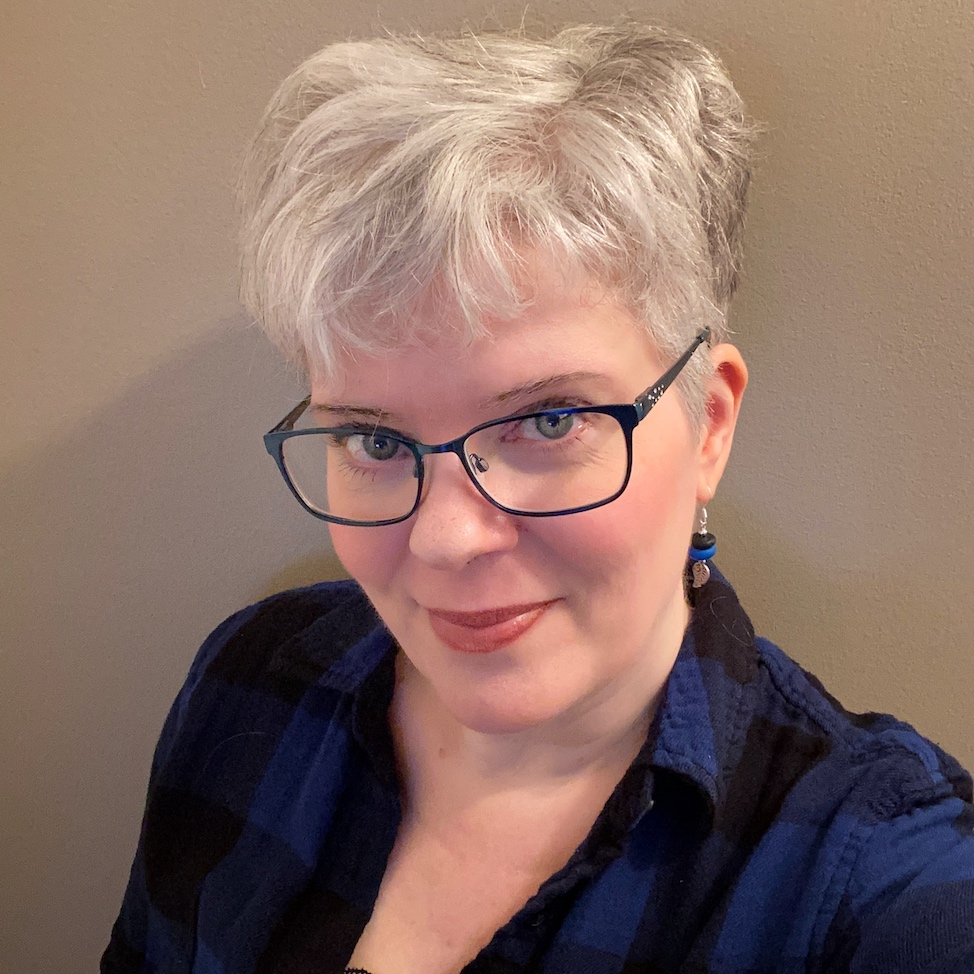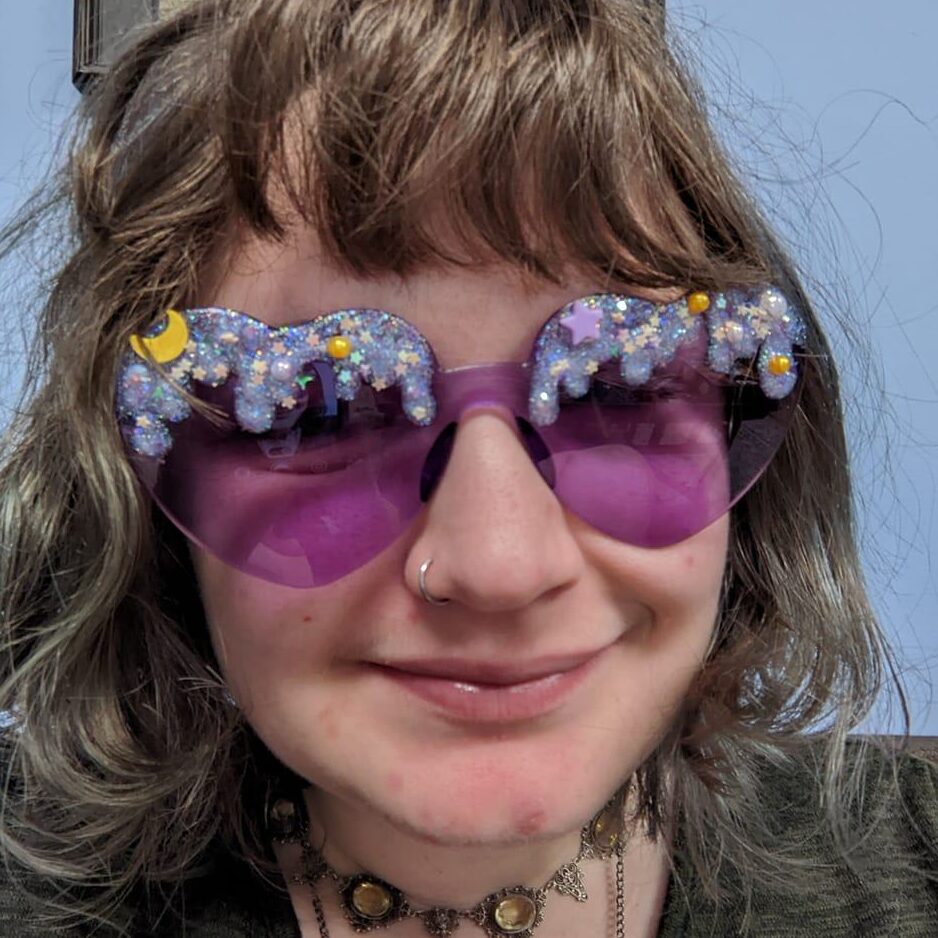In a galactic network known as the Keangal, where space is accessible, Lieutenant Eileen Iris and the command crew of the S.S. SpoonZ haven’t a clue what it means to be disabled. An unexpected conversation with an intergalactic janitor brings up the question, but offers no answers before he’s ’ported away.
Unfazed, duties resume as Iris manages an overprotective guidebot; Security Chief Lartha and her sentient prostheses offer kick-ass protection; Mr. Herbert’s inventiveness is a godsend (although he’s not quite grasped how to flirt); Commander Davan’s affable personality comes through whether trumpeted, texted, or signed; and Captain Warq’s gracious but firm leadership keeps everyone at their best.
Until on one mission, where the crew tears through space. Just a little bit.
We spoke with author Cait Gordon about her book Iris and the Crew Tear Through Space, the space opera and hopepunk genres, and turning a short story into a multi-book series. This interview has been edited and condensed for clarity.
The main genre you write, which includes “Iris and the Crew,” is space opera. What got you into the genre? For some of our audiences who may not know, what defines a space opera?
For me, space opera is science fiction with space adventures, character-driven tales, and often includes the pew-pew-pew! I suppose Star Wars is what first got me into it as a kid in the 1970s, although some might define that franchise as space fantasy. I loved how the first trilogy had such relatable personalities even in a galaxy far, far away.
That kind of storytelling grabs me, so even when I’m writing a space opera that stars alien warriors with scales (The Stealth Lovers), my goal is for readers to identify with the characters. I love unfolding the relationships between the characters too. Space opera allows for that. Welcomes it, even!
Disability is a major theme in Iris and the Crew, as well as in your other works. Many writers fall into tokenizing disabled characters, but your work has it permeate the culture and characters. What drew you to these stories and how much of it was personal experience versus research?
My first book, Life in the ’Cosm (2016), had this side character named Noola, who was disabled with an absolute feisty spirit and lust for life. At the time, she was who I wanted to be; I’d been steeped in fear about my own disability, which stemmed from profoundly internalized ableism. Noola wasn’t ruled by fear, though. She taught me that this should be my goal. So, there was me, influenced by my own character!
In 2018, I wrote my first disabled protagonist, Frank E. Stein, in “The Hilltop Gathering” for the We Shall Be Monsters anthology (edited by Derek Newman-Stille). She was a monster who used a rollator, like me, but she didn’t want the new legs her mother offered for her birthday. At the end of the story, her dad shows up with a suped-up mobility scooter that has a revving motor. Frank E. was elated. That felt correct to my experience. I’d gone from being terrified of mobility devices to embracing them, and putting flame decals on them.
Anyway, this short story ended up being discussed at an international symposium on Frankenstein at Carleton University. I was like, “Wow!” Then, “Hmmm … Stories starring disabled protagonists need to be out there.” I pitched an idea to Renaissance, my publisher, about an anthology of stories written only by disabled authors. Okay, I autisically blurted aloud, and it accidentally became a pitch. But this turned into the Nothing Without Us and Nothing Without Us Too anthologies that I co-edited with Talia C. Johnson. The first one was award-nominated and taught at Trent University and the second just won a Prix Aurora Award.
So, by the time it came to writing Iris and the Crew, I wanted so much disability rep, I joked to people, “There might be some non-disabled, neurotypical people somewhere. It’s a big ship!” I have definitely woven some of my neurodivergent traits through several characters, but this time I wanted an ensemble cast so we could celebrate all kinds of bodyminds in a galactic network that is massively accessible. I wanted to remove the barriers we face as much as possible and make supports easily available. There’s even a ship-wide accessible tech stripe where you can generate assistive tech upon command! I researched like anything for it and had a lot of help from folks with the lived experiences in the book.
“Iris and the Crew” is not only a space opera, but hopepunk. Could you share with us what you know about that genre?
Truth be told, I’d never heard of it until my publisher called it that! My interpretation of hopepunk relates to building a world of inclusion. The galactic network known as the Keangal has a mission to support and accommodate and include. I tried to reflect this in the ship and the assistive tech, some of which are sentient. Like, seriously, don’t grab Lartha’s leg prostheses when they are off her body. Not without their consent. Just don’t.
The prevalent attitudes of hopepunk are about building something with the intent of making life better for all. Fun fact: Keangal is inspired by the Irish word ceangal, which means the connection of things or people, or the joining. I find on Earth, we’re often so divisive, it can be disheartening. So, my brain wanted to go to a place where folks care about the connection between them.
Could you share a bit of what inspired the story and characters?
I’d written a short story called “Wendell and the Crew of the S.S. SpoonZ.” It was for a disability-themed call for submissions. And despite everything I should have known better, I submitted it to the lit mag without having it sensitivity edited. I know, like, Past Cait, what were you thinking?! It got yeeted into the sun. Rightfully so. But Derek Newman-Stille read it and recognized its potential. They said, “You know this needs to be a book, right?”
Um, no, I didn’t.
When the pandemic hit, I couldn’t write for a year. I was so demoralized and frustrated by the constant barrage of eugenics-based messaging. I felt like we who had chronic conditions or who were disabled were “The Onlies,” as in, only we would die or have worse health. I found it dehumanizing.
Then in 2021, my brain needed to escape. I wrote so hard, I could have set my keyboard on fire. I renamed the project to Iris and the Crew Tear Through Space! Then, to be cheeky, I added the “Season One” and wrote titles for 13 chapters, which I called episodes, like a streaming series. As I mentioned, what was different about this book from my other novels was how it would have an ensemble cast of folks who were disabled, Blind, Deaf, non-vocally speaking or selectively speaking, neurodivergent, and/or who managed mental illness. To be super honest, I wanted to panic many times for veering out of my lane, but I soon realized I was lucky. There are not only vloggers and bloggers who share their lived experiences for us to learn from, but I also had three amazing sensitivity editors and several disabled and neurodivergent beta readers.
What I really wanted in this book was to illustrate what it could be like if the real-life concepts of universal design and the social model of disability were integrated into the world-building. I kept thinking, what would it be like if accessibility and accommodation were the norm? So, it’s relational, with found family themes, solid friendships, community, and maybe also the pew-pew-pew. I steered away from deep-dive POV narratives but wanted just enough relatable experience so readers could perhaps find themselves in the story. And it was so much fun writing the accessibility on the ship, which is still called the S.S. SpoonZ!
In my actually life, I have lived in supportive community with humans with all kinds of bodyminds. This might be a love note for all they’ve done for me over the years. An inclusive disability community can be lifesaving, in my opinion.
Season One of Iris and the Crew Tear Through Space! is out. What is in store for the future?
There will be a Season Two! It’s called Iris and the Crew Verb the Noun! (Like I’d really say the title. No spoilers, hahaha!) I’ve also written the foreword and a short story in Mighty: An Anthology of Disabled Superheroes (edited by Jennifer Lee Rossman and Emily Gillespie). My story is called “Putting a Bee in Their Bonnet” and stars an autistic woman in her 50s who hates ABA (Applied Behaviour Analysis) but who loves ABBA. Her superpower? Well, all I can say is with great music comes great responsibility.
I am also working on “the space opera romance that nobody asked for”: Hot Wings and Sauciness. Because people dared me to. It’s really fun and brings me back to my roots in absurdist humour.
Is there anything else you’d like us to know?
I’m fun, feisty, and really love cake. And cosplay. And disabled Barbies. Also Mandalorian FunkoPops.
You can connect with me all over the socials (IG, threads, bluesky, Tumblr, Mastodon) by searching for @caitgauthor. My Facebook page is CaitGAuthor. My author website is caitgordon.com and it lists my books and where to find them. I also founded the Spoonie Authors Network.
Oh, and Iris and the Crew is going to be available in paperback and in ebook and on many online bookshops. It’s still in the process of being distributed! Follow me for updates! To buy it from my publisher, you can follow this link!


